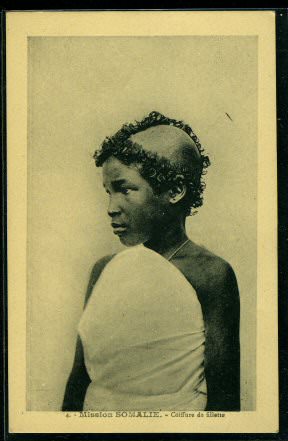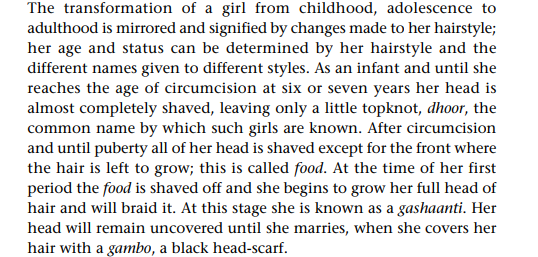You are using an out of date browser. It may not display this or other websites correctly.
You should upgrade or use an alternative browser.
You should upgrade or use an alternative browser.
Do we have our own traditional hairstyle?
- Thread starter Xoxoxo
- Start date
Somali women braided their hair too:


There was also a shared tradition across the Horn and Sudan when it came to kids. They'd shave their hair in funny patterns like this for reasons explained below, at least among Somalis:
A lot of adults, both men and women, just generally grew their hair our out by the looks of it as well:




I'm not sure if it was a thing among women but I know the men also sometimes used ghee or butter to style their hair (like gel) the way Afar nomads still do today.


Odd to think these are the ancestors of men who mostly opt for buzz cuts and women who mostly wear hijabs.
There was also a shared tradition across the Horn and Sudan when it came to kids. They'd shave their hair in funny patterns like this for reasons explained below, at least among Somalis:
Our ancestors didn't cover underage kids' hair. They did however give them odd hairstyles like this which was common all over the Horn and in parts of Sudan:

I remember reading on some knowledgeable Somali's blog that the reason for this, at least among Somalis, was to signify that they were someone underage and not illegible for marriage. Once they were illegible for marriage at around puberty or 15 they would be allowed to grow out their hair.
A lot of adults, both men and women, just generally grew their hair our out by the looks of it as well:
I'm not sure if it was a thing among women but I know the men also sometimes used ghee or butter to style their hair (like gel) the way Afar nomads still do today.
Odd to think these are the ancestors of men who mostly opt for buzz cuts and women who mostly wear hijabs.
Hybrid()
Death Awaits You
Did Somali women used to be barechested before the arrival of the British and Italians ? Most Afar women were barechested until the early 2000s.Somali women braided their hair too:
View attachment 207578
View attachment 207579
There was also a shared tradition across the Horn and Sudan when it came to kids. They'd shave their hair in funny patterns like this for reasons explained below, at least among Somalis:
A lot of adults, both men and women, just generally grew their hair our out by the looks of it as well:
View attachment 207572
View attachment 207573
View attachment 207574
View attachment 207575
I'm not sure if it was a thing among women but I know the men also sometimes used ghee or butter to style their hair (like gel) the way Afar nomads still do today.
View attachment 207576
View attachment 207577
Odd to think these are the ancestors of men who mostly opt for buzz cuts and women who mostly wear hijabs.
Somali women braided their hair too:
View attachment 207578
View attachment 207579
There was also a shared tradition across the Horn and Sudan when it came to kids. They'd shave their hair in funny patterns like this for reasons explained below, at least among Somalis:
A lot of adults, both men and women, just generally grew their hair our out by the looks of it as well:
View attachment 207572
View attachment 207573
View attachment 207574
View attachment 207575
I'm not sure if it was a thing among women but I know the men also sometimes used ghee or butter to style their hair (like gel) the way Afar nomads still do today.
View attachment 207576
View attachment 207577
Odd to think these are the ancestors of men who mostly opt for buzz cuts and women who mostly wear hijabs.
I just want to know how we went from men having long hair to now elders vilifying the younger generations for having long hair in less than 100 years. I mean, our grandfathers probably had long hair as kids.
One word: WesternisationI just want to know how we went from men having long hair to now elders vilifying the younger generations for having long hair in less than 100 years. I mean, our grandfathers probably had long hair as kids.
Don't you get concerned about getting LARP'd?
Did Somali women used to be barechested before the arrival of the British and Italians ? Most Afar women were barechested until the early 2000s.
Colonials had no real effect on the culture in this sense, to be honest, especially among traditional rural types. Besides, Somali territories were mostly protectorates being run by local Sultans, chieftains and traditional xeer law. Not to mention that a lot of the images we have, especially a lot of the engravings, predate Britain, Italy and France's presences or are very close to when these colonial powers first began showing up.
Hybrid()
Death Awaits You
Isse women who border afars used to be barechested until the early 1900s and I saw some old images of barechested Somali women so I was wondering if that was ever part of Somali culture.Colonials had no real effect on the culture in this sense, to be honest, especially among traditional rural types. Besides, Somali territories were mostly protectorates being run by local Sultans, chieftains and traditional xeer law. Not to mention that a lot of the images we have, especially a lot of the engravings, predate Britain, Italy and France's presences or are very close to when these colonial powers first began showing up.
So we really wuz kangz? That aside all cultures have traditional hairstyles and different traditional braiding styles are common. So somalis have.Habesha’s actually have their own hairstyles, Fulani braids are well, Fulani braids and box braids are from ancient Egypt.
do we have our own hairstyles?
There was also a shared tradition across the Horn and Sudan when it came to kids. They'd shave their hair in funny patterns like this for reasons explained below, at least among Somalis:

Somalis don't practice it anymore, but you can find modern pictures of Borana still doing it
Hybrid()
Death Awaits You
Do you know what year that article was originally written. My grandfather was born in the 1920s and I never heard this shaving practice from him.
Somalis don't practice it anymore, but you can find modern pictures of Borana still doing it
Do you know what year that article was originally written. My grandfather was born in the 1920s and I never heard this shaving practice from him.
The PDF is from 2004, I'm pretty sure the practice died along time ago
Slide 20 in this colonial Somalia slideshow is dated 1936, slide 19 (1936) baby on mother's back and another (undated) on slide 45:
You don't have permission to view the spoiler content.
Log in or register now.
Slideshow from colonial Djibouti: slide 35 child bottom left with part head shaved at a wedding, slide 36 more kids with shaved head, slide 34 looks like a man with part of his head shaved??
Last edited:
Hybrid()
Death Awaits You
Thank you so much for those PDFs. I'm surprised that some Somali women were barechested in the 1900s. in colonial somalia: slide 33 and 34, are these women Somali or bantu ?The PDF is from 2004, I'm pretty sure the practice died along time ago
Slide 20 in this colonial Somalia slideshow is dated 1936, slide 19 (1936) baby on mother's back and another (undated) on slide 45:
You don't have permission to view the spoiler content. Log in or register now.
Slideshow from colonial Djibouti: slide 35 child bottom left with part head shaved at a wedding, slide 36 more kids with shaved head, slide 34 looks like a man with part of his head shaved??
I have seen Reer Miyi doing this in mid to late 90s. As a kid we used to pick o them. Dhoor is the hair left on top of the head, like Arma's photo and sometimes a little circle of hair in the middle of the head.Do you know what year that article was originally written. My grandfather was born in the 1920s and I never heard this shaving practice from him.
The terms: Foodley, Gashaanti are still used. Dhoocil and Foodley are interchanged for teen to preteen girls. Gashaanti has no age just means not married ever/ ready for marriage.
Hybrid()
Death Awaits You
Ive never heard of this practice in somaliland. Maybe it was discontinued much earlier in somaliland but I've heard of the word foodley being used on teenage girls once in a while. in waqooye the interchangeable word for dhoocil is actually "gambayar" but is only used on females.I have seen Reer Miyi doing this in mid to late 90s. As a kid we used to pick o them. Dhoor is the hair left on top of the head, like Arma's photo and sometimes a little circle of hair in the middle of the head.
The terms: Foodley, Gashaanti are still used. Dhoocil and Foodley are interchanged for teen to preteen girls. Gashaanti has no age just means not married ever/ ready for marriage.
They look BantuThank you so much for those PDFs. I'm surprised that some Somali women were barechested in the 1900s. in colonial somalia: slide 33 and 34, are these women Somali or bantu ?
